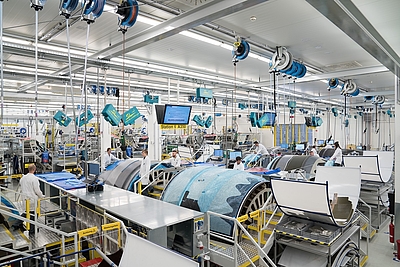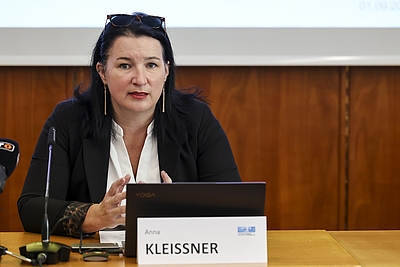“Lightweight construction is special”
05.07.2023
In Austria, lightweight construction generates 9.4 billion euros in added value and secures 77,400 jobs. This is the result of a study conducted by Anna Kleissner on behalf of the Austrian Lightweight Platform and the industry division of the Austrian Federal Economic Chamber. The economist discussed the details with Automotive Cluster Manager Florian Danmayr.
What were the study’s most exciting and surprising findings?
The most exciting thing was that this economic appraisal of lightweight construction was pioneer work. The fact that no real figures had ever been collected on it world-wide was surprising. For me, as a non-techy, it was exciting to discover that lightweight construction still has so much untapped potential. In the end, we got to the point where we realised every second sector in our economy is related to lightweight construction in some way. So it was hardly surprising that the economic significance turned out to be huge. Lightweight construction is comparable to other cross-sectional matters like tourism or sport and yet very special, because it is not only product-based but also has a third important component: process orientation. It changes the production functions and processes – and by doing so, it also changes the raw material input and the cost structure. As importers of raw materials, this puts us in a completely new position, when we can change these structures and break out of existing patterns. And now we have a tool to visualise the economic effects and make them comparable.
What share of value creation does lightweight construction account for in Austria?
We measured 9.4 billion euros of direct value added. Based on GDP, this means that lightweight construction accounts for 2.6 percent of our economy. But for a correct appraisal, we also need to add the required inputs and goods, that is, the upstream value chain, and the income and investment effects triggered by lightweight construction, that is, the downstream value chain. Including those effects takes us to more than 16 billion euros of value added, or a contribution of 4.6 percent. That’s incredibly high. Entire sectors, such as the construction industry, or the entire food services (restaurants, bars, catering,...) only achieve about half of what lightweight construction contributes to the economy.
And how important is lightweight construction for employment?
Lightweight construction is particular value added intensive, but still there are 77,000 jobs directly linked to it. A large number of jobs are being created in the upstream and downstream chain – even more than in lightweight construction itself. All told, you can add another 140 percent, which means that lightweight construction is securing just south of 190,000 jobs in Austria at the moment. That is a contribution of more than four percent. This makes the impact of lightweight construction very clear, but it’s something you can’t see in the statistics at first glance.
Is it true to say that lightweight construction creates jobs?
Absolutely, it’s this economic leverage that lightweight construction triggers in the area of employment that makes it so special. Lightweight construction is an employment multiplier – it creates leverage in the domestic economy at a factor of 2.4, which is very rare, even for a multiplier. To show this impact across so many sectors is something quite special.
What were the biggest challenges with this study?
Defining lightweight construction. That’s quite tricky from an economist’s point of view. We turned to experts from specific areas, but even after talking for hours, it wasn’t easy to say what lightweight construction includes, what is distinct from it, and what is only linked to it in some way. We made a giant leap there. The second challenge was that our statistics are not designed to let us quantify lightweight construction. In other words, the information we need in order to get what we’re looking for is not available in this form from existing statistics. So we needed primary data and an enormous number of expert interviews. That’s something we need to address moving forward. The more important lightweight construction becomes, the sooner we need to start collecting the data. This will make it easier for us to quantify the economic value of lightweight construction in the future.
What are the remaining challenges for what comes next?
We have been able to define the goods and activities, but we need significantly more input for the process-oriented component. That’s because, in terms of the approach, a lot of tweaks are applied at the same time. We need specialists in every sector to help us reconcile economics and technology and present both correctly. We also need to lift the approach we chose in Austria up to the European level at the same time. Not just to prevent the research being purely domestic, but because it is exciting to see the weight that lightweight construction carries at a European level. This will enable us to point to developments, analyse scenarios and pursue regional economic policies. What are we lacking locally? In which areas do we have potential for development? What are our specific advantages compared with competitors? We can answer all these questions if we have access to European figures.
In other words, comparability is an important keyword if you need to communicate change over time.
Right. The very first cross-sectoral topic to be mapped out in this way was tourism. The economic significance only becomes clear when it can be expressed in figures. It is also far easier to deal with funding and it affects how a sector is seen politically. Sports was exactly the same. In terms of statistics, sports accounts for 0.3 percent of the economy, and this is roughly the value that was assigned to it politically. But we now know that sports accounts for more than five percent of the total value added in Austria. I believe that we have now laid the same foundations for lightweight construction. From now on, everything else will be easier.
Would Germany, for example, be a good starting point for this evaluation to communicate the pan-European significance of lightweight construction?
In its Horizon Europe 915 research funding program, the EU set up various programmes and examined their relevance to lightweight construction. Only six funding programmes explicitly target lightweight construction, which clearly shows how underrepresented the topic has been or how little awareness there was of it. This is why I believe that we are now seeing greater relevance, visibility, and support at the funding level, which is very much aligned with the Green Deal and the challenges of climate change.
Talking Heads
Podcast with the author of the study Anna Kleissner and Stefan Seidel, CTO Pankl Racing Systems and spokesperson of the A2LT lightweight construction platform.
>> Listen to podcast (in German only)
| Anna Kleissner studied economics in Graz and has more than 20 years of experience in economic research, and political and business consulting. Her main areas of expertise are regional economics and structural change, national accounting including satellite accounts, impact analysis, energy and mobility transition as well as sport economics. Kleissner started her career at the Institute for applied sciences Carinthia, worked as a senior researcher and member of the board at the Economica Institute for Economic Research, and was management director of SportsEconAustria Institute for Sports Economics, TwinEconomics, a research company based in Cologne, Germany, and Ex- Aqua Research. Since 2020 Kleissner has been managing her own company Econmove . She is also lecturer at different universities in Austria and Germany. The mother of one son is also involved in voluntary work, for example, as a member of the Business Women’s Centre board and chair of the grassroots sports commission of Bundes-Sport GmbH (BSG). www.econmove.at |

